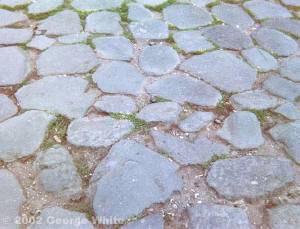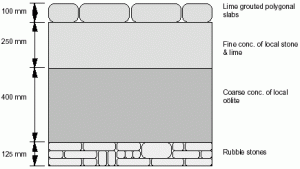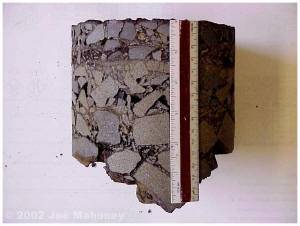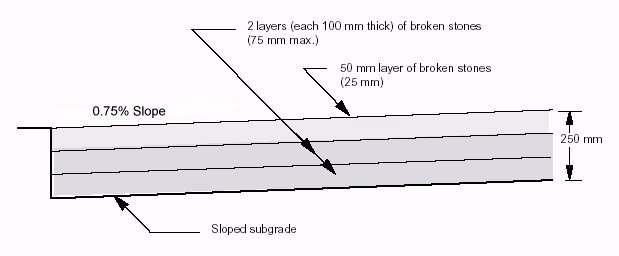Asphalt Pavement History
Hot mix asphalt (HMA) pavements have existed in their present form, as a mixture of angular aggregates and asphalt binder, since the beginning of the 20th century. However, HMA pavement can trace its roots back to ancient Roman roads and beyond.
The first recorded use of asphalt by humans was by the Sumerians around 3,000 B.C. Statues from that time period used asphalt as a binding substance for inlaying various shells, precious stones and pearls. Other common ancient asphalt uses were preservation (for mummies), waterproofing (pitch on ship hulls), and cementing (used to join together bricks in Babylonia). Around 1500 A.D., the Incas of Peru were using a composition similar to modern bituminous macadam to pave parts of their highway system. In fact, asphalt is mentioned several times in the Book of Genesis (Baird 2002).
In more modern times, asphalt paving uses first began with foot paths in the 1830s and then progressed to actual asphalt roadways in the 1850s. The first asphalt roadways in the U.S. appeared in the early 1870s (Abraham 1929).
Roman Roads
The oldest Roman road still in use today, Via Appia (Figure 1), dates back to 312 B.C. At its height, the Roman road network consisted of over 62,000 miles of roads. By law, all of the public was entitled to use Roman roads, but the maintenance of the roadway was the responsibility of the inhabitants of the district through which the road ran (the same basic system used in the U.S. today). Although Roman roads did not use asphalt as a binder, they did often use lime grout and other natural pozzolans as binders. Figure 2 shows a typical Roman road structure.

Figure 1: Roman Road Surface

Figure 2: Roman Road Structure
Telford Pavements
Skipping forward several thousand years, Telford pavements begin to show likeness to today’s modern HMA pavements. Thomas Telford (born 1757) served his apprenticeship as a building mason (Smiles 1904). Because of this, he extended his masonry knowledge to bridge building. During lean times, he carved gravestones and other ornamental work (about 1780). Eventually, Telford became the “Surveyor of Public Works” for the county of Salop (Smiles 1904), thus turning his attention more to roads. Telford attempted, where possible, to build roads on relatively flat grades (no more than a 1 in 30 slope) in order to reduce the number of horses needed to haul cargo. Telford’s pavement section was about 14 to 18 inches in depth as shown in Figure 3. Telford pavements did not use any binding medium to hold the stones together.

Figure 3: Typical Telford Road (after Collins and Hart 1936)
Macadam Pavements
Macadam pavements introduced the use of angular aggregates (Figure 4). John McAdam (born 1756 and sometimes spelled “Macadam”) observed that most of the “paved” U.K. roads in the early 1800s were composed of rounded gravel (Smiles 1904). He knew that angular aggregate over a well-compacted subgrade would perform substantially better. He used a sloped subgrade surface to improve drainage (unlike Telford who used a flat subgrade surface) onto which he placed angular aggregate (hand-broken, maximum size 3 inches) in two layers for a total depth of about 8 inches (Gillette 1906). On top of this, the wearing course was placed (about 2 inches thick with a maximum aggregate size of 1 inch) (Collins and Hart 1936). Macadam, who did not use any binding medium to hold the stones together, realized that the layers of broken stone would eventually become bound together by fines generated by traffic. The first macadam pavement in the U.S. was constructed in Maryland in 1823.

Figure 4: Macadam Pavement Core

Figure 5: Typical Macadam Road (after Collins and Hart 1936)
Tar Macadam Pavements
A tar macadam road consists of a basic macadam road with a tar-bound surface. It appears that the first tar macadam pavement was placed outside of Nottingham (Lincoln Road) in 1848 (Hubbard 1910; Collins and Hart 1936). At that time, such pavements were considered suitable only for light traffic (i.e., not for urban streets). Coal tar, the binder, had been available in the U.K. from about 1800 as a residue from coal-gas lighting. Possibly this was one of the earlier efforts to recycle waste materials into a pavement!
As a side note, the term “Tarmac” was a proprietary product in the U.K. in the early 1900s (Hubbard 1910). Actually it was a plant mixed material, but was applied to the road surface “cold.” Tarmac consisted of crushed blast furnace slag coated with tar, pitch, portland cement and a resin. Today the term “tarmac” is generic and generally refers to airport pavements (however, inappropriately).
Sheet Asphalt Pavements
Sheet asphalt placed on a concrete base (foundation) became popular during the mid-1800s with the first one of this type being built in Paris in 1858. The first such pavement placed in the U.S. was in Newark, New Jersey, in 1870. Generally, the concrete layer was 4 inches thick for “light” traffic and 6 inches thick for “heavy” traffic (Baker 1903). The final thickness was based on the weight of the traffic, the strength of the concrete and the soil support.
Bitulithic Pavements
HMA pavement began to take on its modern form around the beginning of the 20th century when Frederick J. Warren was issued patents for a “hot mix” asphalt paving material and process, which he called “bitulithic”. A typical bitulithic mix contained about 6 percent “bituminous cement” and graded aggregate proportioned for low air voids. The concept was to produce a mix which could use a more “fluid” binder than was used for sheet asphalt. Warren received eight patents in 1903. A review of the associated claims reveals that Warren, in effect, patented HMA, the asphalt binder, the construction of HMA surfaced streets and roads, and the overlay of “old” streets.
In 1910 in Topeka, Kansas, a court ruling stated that HMA mixes containing 0.5 inch maximum size aggregate did not infringe on Warren’s patent (Steele and Himmelman 1986). Thus, most U.S. hot mix asphalt (HMA) thereafter became oriented to the smaller maximum aggregate sizes. A typical “Topeka mix” consisted of 30 percent graded crushed rock or gravel (all passing the 0.5 inch sieve), about 58 to 62 percent sand (material passing the No. 10 sieve and retained on the No. 200 sieve), 8 to 12 percent filler (material passing the No. 200 sieve). This mixture required 7.5 to 9.5 percent asphalt cement. By 1920, Warren’s original patents had expired in the U.S. (Oglesby and Hewes 1962) but the legacy of the Topeka mix lived on as reflected by the U.S. tendency towards finer mixes.



